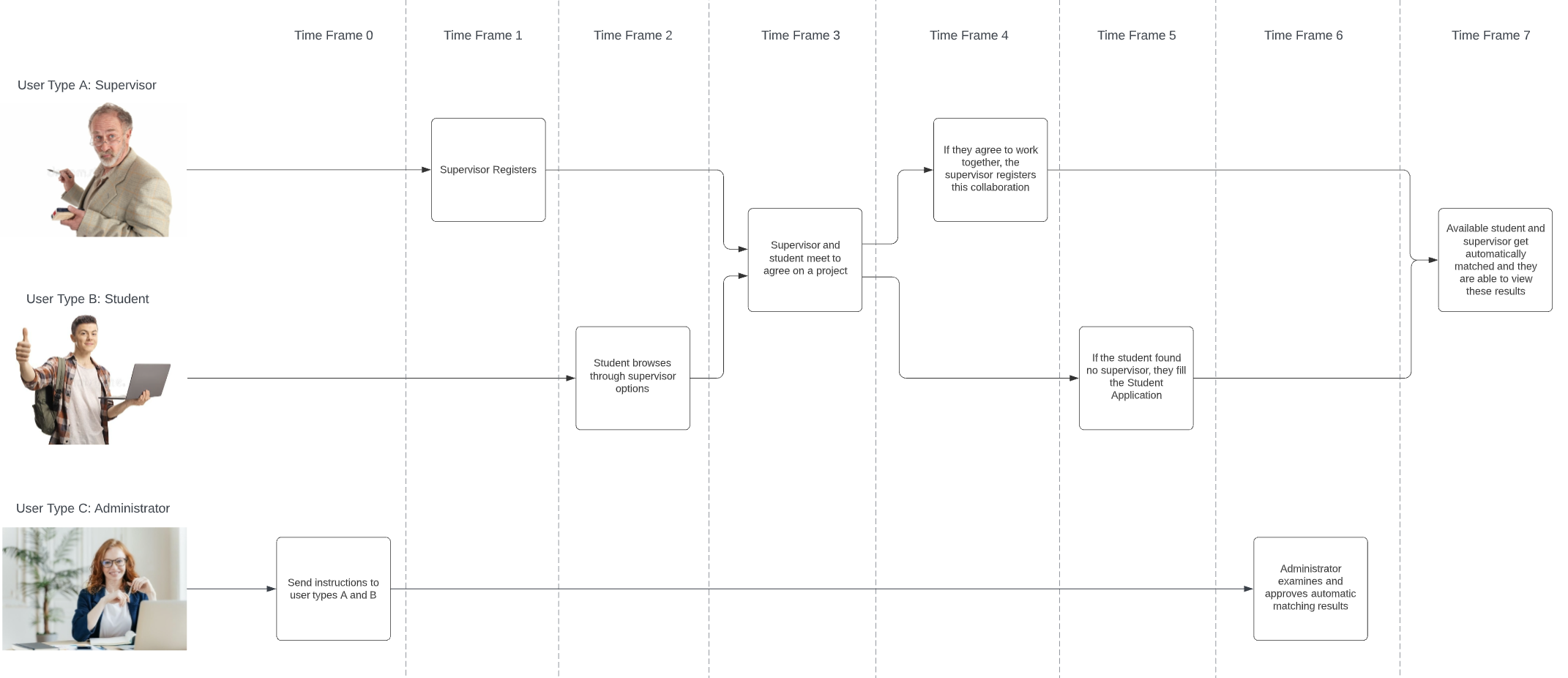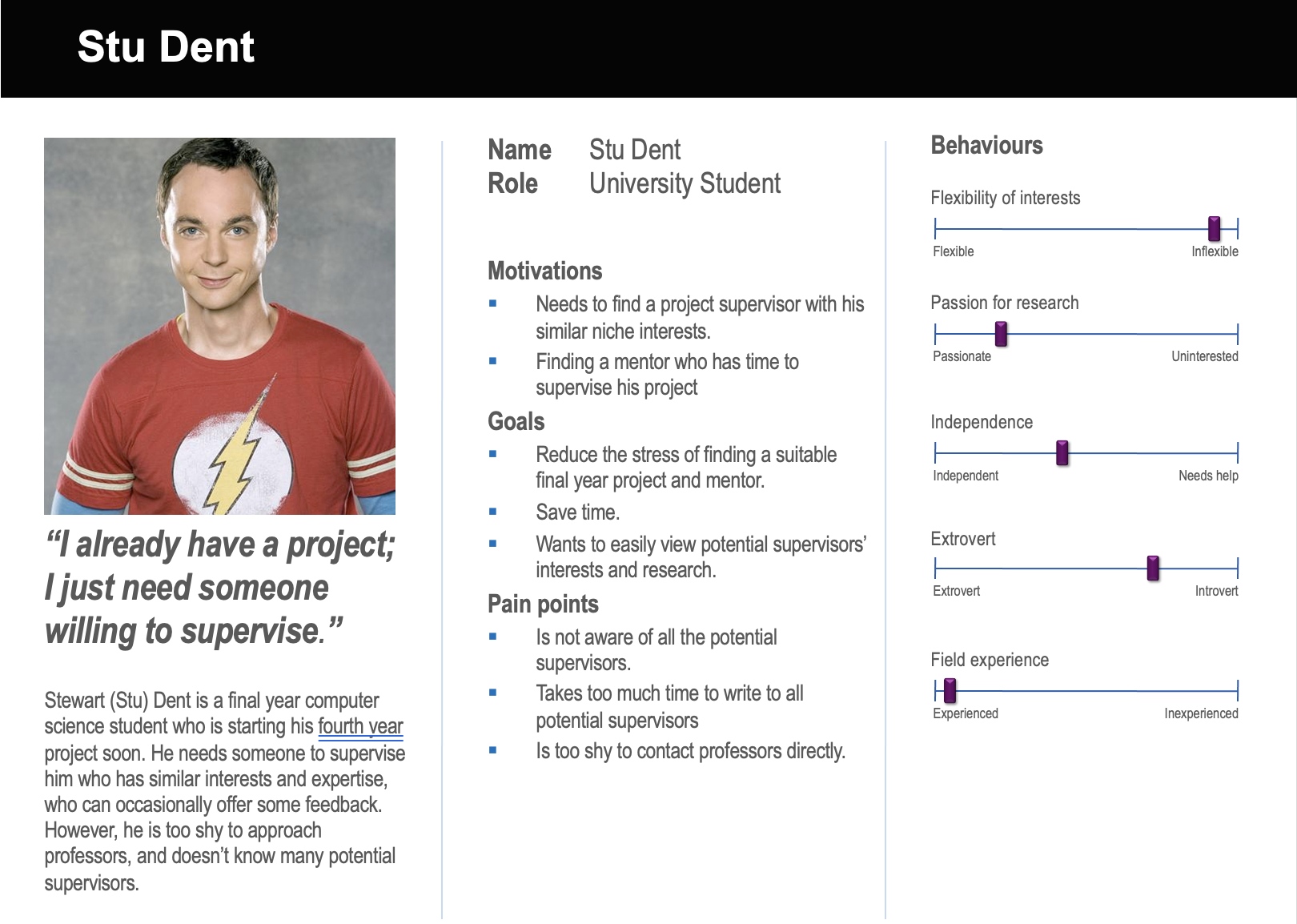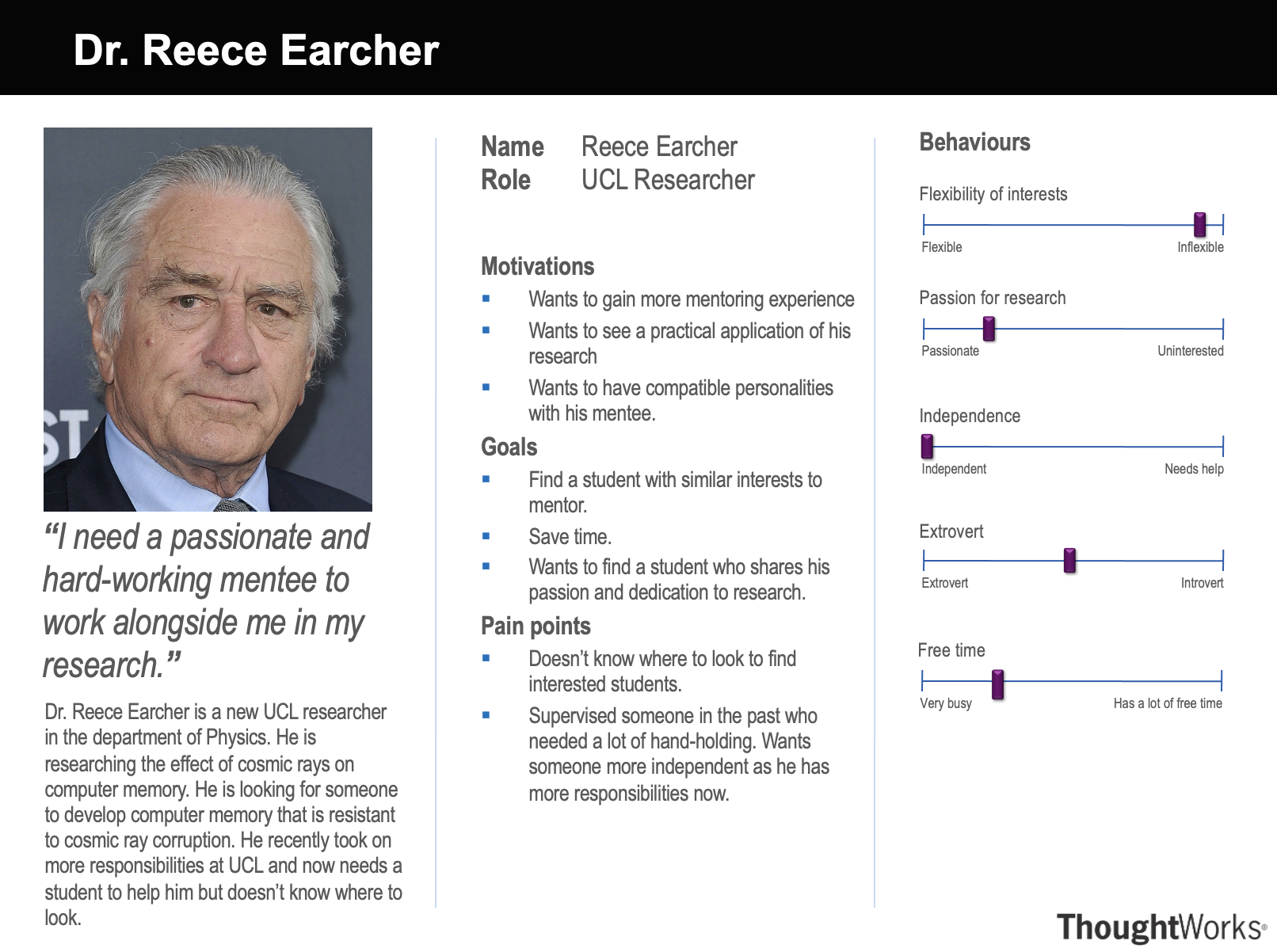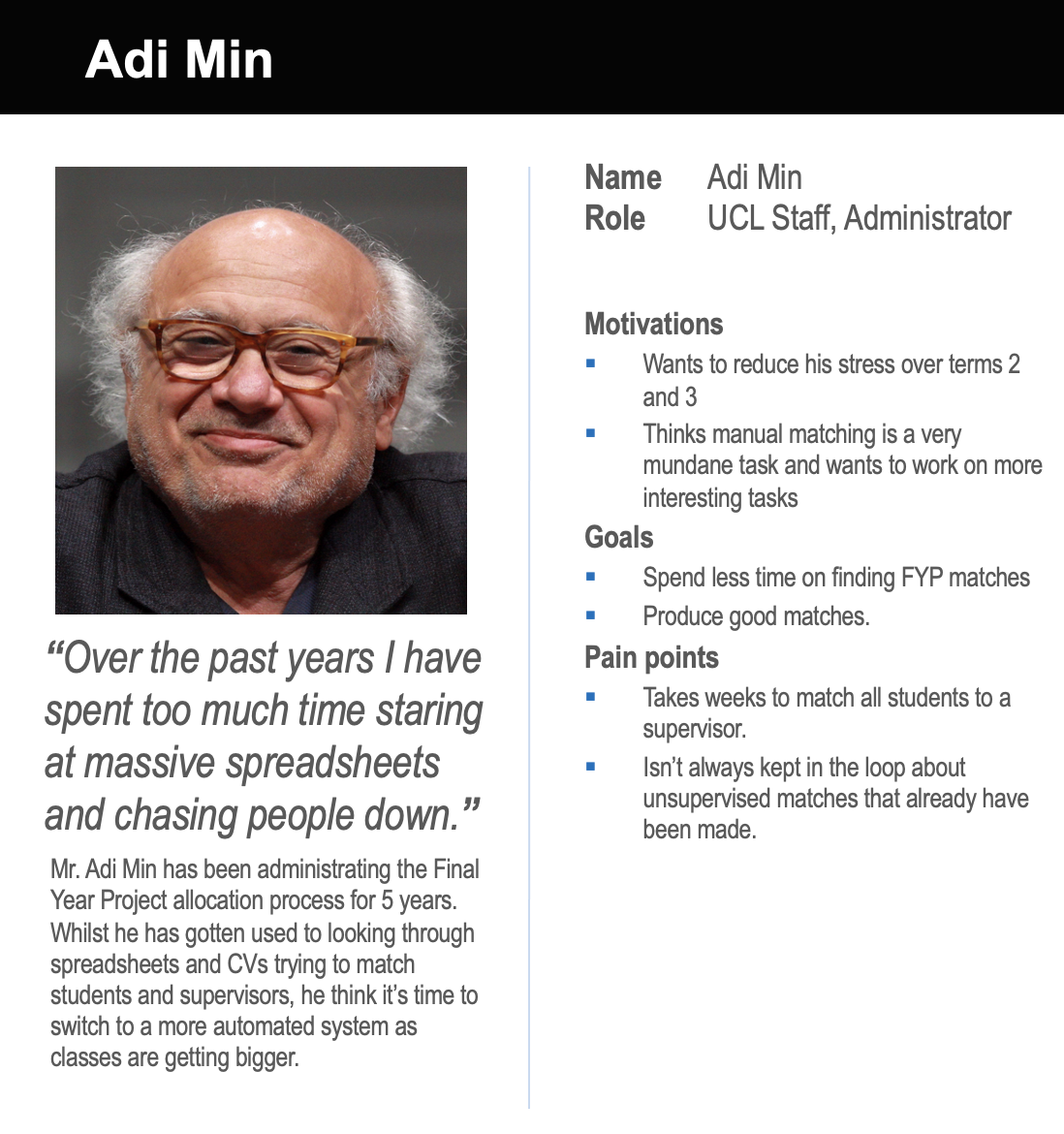Requirements
UCL’s Computer Science department has recently been transitioning several day-to-day activities in the form of business transformation as workflows. In partnership with Microsoft, several tools and systems have been requested across the teaching and learning domains.
The highest burden faced by our client, Dean Mohamedally, is the Final Year Project Supervisor Allocation process which is being done manually. This involves finding a supervisor who would be good a match for each of 160 students in the class, which is a time-consuming process.
The Current SolutionThe current solution is not fit for purpose and involves multiple stages of spreadsheets, conflicting requests, and lack of timelines.
The process should allow a first-round survey to all final year students, to state their degree level, and whether they intend to do research only, industry only, or don’t know as their profile option.
Visibility of projects is a key ask for the academics - this includes research projects listing, ACM classification keywords of the academics, and visibility of the industry projects lists once they are ready. A solution that enables staff workloads to be input is needed at this point as those academics that have capacity to supervise and are not taken by students for their research projects, should then automatically make themselves available for projects with industry.
The second-round survey is the matching of the students to the research projects. This needs timeframes to be set up that mark key dates: when projects are advertised, when the projects are taken by a student, or if a student is in discussions with an academic for a project. Only once this is facilitated, it will be then signed off as allocated as FYP for Research Academic Projects.
After that stage, or in parallel, for students that have said yes to wanting industry projects on the UCL IXN, they will fill in a separate second round survey, called the UCL Motivation Tracking Survey. This data then profiles capabilities and allows a Teaching and Learning member of the team to import the student grades for the IXN and Strategic Alliance Teams to begin sourcing appropriate projects in those quantities.
By March this data is completed and those who said they did not know will be once again advertised to come forward to choose in a 3rd cycle of survey forms.
Academics need a listing that enables them to see, at a glance, who they are supervising as final year projects are allocated.
-
Easy-to-use interface for staff, students and administrators
-
Bring all steps of the FYP allocation process to one place
-
Store all relevant data in one location
-
Facilitate unsupervised matching
-
Automate supervised matching
At the start of our project, we interviewed 4 students, 2 academics, and the administrator who is overseeing the FYP supervisor allocations this year.
We decided to go with a semi-structured interview as the method of gathering information from would be users. We probed topics such as what they would like to be able to do with a new system and thoughts they had about the current system. We deemed this more appropriate than a questionnaire as people are more reluctant to be thorough and descriptive in questionnaires. We felt that it was also appropriate to ask open interview questions to really understand what the users want.
Below are notable points from answers to the questions we asked.
-
The process struck me as unorganized. I had trouble finding the place to look for the list of supervisors – it turned out it was on the systems engineering Moodle page.
-
I had a difficult time reading through the list of available supervisor options. A code was used to list their ACM keywords, so I had to look up the code every time. I wish it was easier to browse the list of supervisors. Also, my device had a glitch with the file that listed all the ACM keywords, which made browsing more difficult.
-
The process itself was okay, though I would’ve preferred a separate Moodle page for it and an email that would notify everyone simply about the deadlines.

-
It would be great to have everything happen through one medium. I managed it this year, but it would’ve obviously been easier and cleaner if everything went through a single medium, rather than many strewn forms. I suspect the process would’ve been more on-schedule as well if the administrators didn’t have to manage all these forms and mediums of communication.
-
If possible, that sounds great! But it should certainly be linked with UCL so I don’t have to remember more credentials. I also want it to be easily memorable and accessible so I don’t keep forgetting what the website’s called or where to find the link.
-
It would be great to have everything happen through one medium. I managed it this year, but it would’ve obviously been easier and cleaner if everything went through a single medium, rather than many strewn forms. I suspect the process would’ve been more on-schedule as well if the administrators didn’t have to manage all these forms and mediums of communication.
-
If possible, that sounds great! But it should certainly be linked with UCL so I don’t have to remember more credentials. I also want it to be easily memorable and accessible so I don’t keep forgetting what the website’s called or where to find the link.
-
On average, I have had success with it. I usually fill most of my spots during unsupervised allocation, which is nice because I get to pick who to supervise.
-
It’s alright, this year they sent out a new, well-formatted form for us to register as supervisors. Despite the fact it was a bit long, I don’t have trouble with it. I have found some great students to supervise this way. The only issues I've ever had were with students who were allocated to me by the administrator, because sometimes we had little in common and I felt I couldn’t provide the best advice on their dissertations.
-
I want to convey my research groups and link students to my previous works. In previous years we were asked to provide our ACM keywords, and I think that’s also a good metric. Some think it’s outdated but I think in this case, it is fit-for-purpose.
-
I like to leave a customized message because I usually have specific projects in mind and want students who are interested in them to contact me directly.
-
I want to convey I am only available to supervise industry projects because I am not a researcher.
It can take a lot of time to read through students’ answers and the available staff and try to match them such that everyone is happy. There are a lot of dimensions to consider, so this can be quite a taxing task. There are also some students who don’t find a supervisor on their own and then don’t fill the form in, so I have to chase them down. Sometimes there are also students and academics who agreed to work together but didn’t tell us, and this causes confusion and a lot of back and forth. On top of all of this, I need to orchestrate the entire process, from preparing forms, to getting that data out in a readable format, to making sure students and staff are on board and well informed. It’s generally a lot of work.
What are you most looking forward to getting out of this project?I am excited to not have to spend as much time organizing each step and doing everything by hand. It took a very long time to come up with a document for students' supervisor options. I had to create a list, too, for them to see the ACM keywords. It took a very long time. If the system can handle displaying the correct inputs and outputs of data for each staff and student, that would already cut down on a big task. The automatic matching is very useful too - I could free up time to spend it better dealing with outliers or special cases. I also think this could be replicated and used in many other situations and potentially by other institutions to solve similar problems.
What functionalities do you see as essential?I want it to be possible for professors to agree with students to work together before doing any automatic matching. Please also make sure the administrator knows of all such pairs made. I want to use ACM keywords to implement the matches. Academics should be asked to select their ACM keywords, and I also want it to be possible for students to select some ACM keywords they want to be matched by. This is particularly for students interested in research. A page where the students can just type a link and see all the available supervisor options would be great.
 Supervisor
Supervisor
|
Use Case |
Action Flow |
Result |
|
Register As a Supervisor |
|
Submitted information for students to view in unsupervised matching and to be used in supervised matching. |
|
View or Edit Application |
|
Supervisor viewed or edited their Supervisor Application responses. |
|
Register a Supervisee |
|
Supervisor informed the administrators they will be supervising the selected student for their Final Year Project. |
|
View Supervisees |
|
The supervisor may view a list of all the students they will be supervising. |
|
Edit Supervisees |
|
Edited details about a student they will be supervising. |
|
Remove Supervisee |
|
Removed record of student they will be supervising. |
|
Use Cases for Students |
||
|
Use Case |
Action Flow |
Result |
|
Browse Supervisor Options |
|
Can view information about which academics are available to supervise Final Year Projects. |
|
Apply For Automatic Matching |
|
Submitted application to be automatically allocated a supervisor. |
|
View or Edit Application |
|
Student viewed or edited their Student Application responses. |
|
View Allocated Supervisor |
|
Student may view the supervisor they will be working with for their Final Year Project. |
|
Use Cases for Administrator – Portal |
||
|
Use Case |
Action Flow |
Result |
|
Trigger Automatic Matching |
|
Available students have been matched to available supervisors. |
|
Use Cases for Administrator – Model-driven App |
||
|
Use Case |
Action Flow |
Result |
|
Approve or Reject Matches |
|
Accepted or rejected a match made automatically. |
-
Must-have
- Academics can be manually and automatically allocated to students based on common interests.
- Academics can report the research groups they are a part of and ACM keywords that their work falls under when registering to supervise.
- Academics who have agreed on a project with a student can soft book them through the system.
- Administrators of the process must be able to approve of reject matches made by the system and any pre-allocation soft bookings made by users.
-
Should-have
- Academics hosting students annually can easily update and resubmit their previous application.
- Students can view available supervisors through a searchable list or table.
-
Could-have
- Filled applications are editable unless the administrator opts to make them read-only.
- The solution monitors student interest over many years.
- The solution automatically gathers supervisors' ACM keywords from published works.
-
Won't have
- The solution will not concern the allocation of industry students to industry projects. The solution will not provide a communication channel through which students can directly contact supervisors or vice versa.


